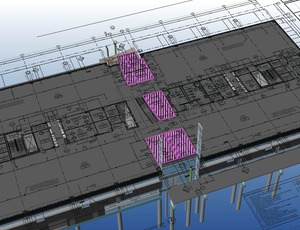

Estimators have never had it easy in the rough-and-tumble world of construction cost estimating—especially when using traditional 2D files or drawings for quantity takeoffs and cost estimates. More than a few still lie awake at night, wondering what materials they might have overlooked in a complex change order.
But things are looking up for estimating departments. Thanks to the advance of building information modeling tools that can integrate model-based data into an array of platforms, quantity takeoffs and cost estimates are getting more granular, which is changing how projects are run.
As more managers link model-based design to project schedules to achieve 4D BIM, they are increasingly taking their work to a new level and, in addition, extracting quantitative data from models for cost estimating, or what's known in general as 5D BIM.
It's not easy. Any firm achieving 5D BIM for supporting cost estimating is doing so by deploying a complex alchemy of processes. They may include using application programming interfaces (APIs) that help pull data from a schedule-loaded model to inform quantity takeoffs and running those data extractions through another platform before referencing an estimating database to calculate costs, to name just a few hops.
"The model doesn't represent the entire scope of the project," explains Chris Bailey, a vice president and director of project controls for construction management firm STV Group, based in New York. "There is no little red button in the corner of Revit [or other authoring tool] that says 'push for estimate.' It doesn't happen," he adds. "It probably never will."
Bailey, who heads up a team that used BIM 4 and 5 on the Delta Airlines terminal rehabilitation project at JFK Airport, says STV saw the need to integrate software from independent products, rather than just buying into an umbrella of one firm's products. For example, STV is working with Autodesk's Revit authoring tool to access a project's design model, software by Assemble Systems for model comparisons, Oracle's Primavera P6 for schedule loading and Sage's Timberline database for generating cost estimates. The firm works with software vendors' APIs to create a platform that can interoperate with different software products. "This is all about core data," Bailey says of the firm's approach, which it calls BIM456. "We're making sure the data is right from the beginning and then used for different purposes."
Communication Complexities
Software vendors are sensing a readiness—even a shift in the market—among firms that are wrestling with the data integration complexity that 5D BIM demands. For example, Trimble/Vico says its recent release of its Office R5 software suite is targeting cost estimating that "extends basic 3D models to add BIM 4D, 5D and 6D applications." 6D refers to facilities management data. During a recent overview of the software modules, Vico highlighted new features in the Office R5 suite, including enhanced 2D- and 2D/3D-hybrid takeoff capabilities, improved running modes visualization, cost add-on and markup capabilities, new web services, and expanded Industry Foundation Classes import capabilities.
"What Vico does is link your model and your quantities with your cost estimating database," says Aaron Wright, integrated construction director with Hoar Construction. "If there are other tools that can do this, such as Timberline, they haven't advanced as far as Vico has, or don't do the same things Vico Cost Planner does," he says of the Vico system.
Wright is quick to point out that it took the firm about a year to get ramped up to 5D as it expanded its BIM capabilites. "Our whole virtual design and construction journey has led us to discover new things about ourselves as a team and a company. That's led us to exploring a way to develop a better understanding of cost history, which led us to tools beyond Vico and Trimble, such as Assemble Systems, web-based software that many firms use to compare models," he says. "We are heavy users of Assemble because it makes our connection to Vico faster and better."

Post a comment to this article
Report Abusive Comment